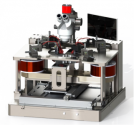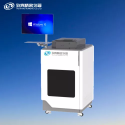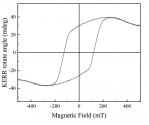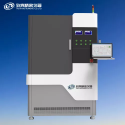Testing Chips with magnets?
Zhizhen Precision Instrument (Qingdao) Co., Ltd. is a national high-tech enterprise whose main business is the R&D and production of integrated circuit production line testing equipment and high-end scientific instruments. In the context of the rapid development of China's integrated circuit manufacturing industry and the urgent need for independent and controllable equipment in chip R&D and manufacturing, Zhizhen Precision Instrument has not yet achieved domestic success through independent innovation, industry-university-research cooperation, achievement transformation, and industry resource integration. Relevant high-end instruments and equipment with independent research and development capabilities have carried out engineering research.
Since its establishment in 2019, the company has gathered more than 50 talents of various types, and built an engineering team with a complete range of jobs in optics, electricity, precision machinery, measurement and control and automation, software and algorithms. , to introduce a number of expert-level talents. The company has successively established joint laboratories with Beihang University, Beihang University Qingdao Research Institute and Beihang University Hangzhou Research Institute to give full play to the advantages of industry-university-research integration to accelerate research and development. The company has subsidiaries in Beijing and Hangzhou. At present, the company has developed a series of domestic first sets of high-end equipment for the needs of the magnetic chip and integrated circuit manufacturing field, including China's first commercial magneto-optical Kerr microscope, industrial-grade wafer magneto-optical Kerr tester, etc. The products have been used in domestic top scientific research institutions and well-known integrated circuit manufacturing companies such as Tsinghua University and Chinese Academy of Sciences.
[Wafer level] Semi-automatic magnetic field probe station [1] Semi-automatic in-plane magnetic field probe station PS1DX-Auto8 3D renderings Project detailed parameters Magnetic field direction and maximum magnetic field strength In-plane magnetic field; ≥330 mT Whether the air gap is adjustable or not Size 12" Wafer (Backward Compatible with Fragment Test) Probe Type...

Using the magneto-optical Kerr effect to measure the hysteresis loop of magnetic materials, the in-plane hysteresis loop and the vertical hysteresis loop can be measured synchronously.


The magneto-optical Kerr effect (MOKE) is used to rapidly and globally detect the magnetism of the wafer stack. Non-contact measurement avoids the damage to wafers caused by traditional magnetic characterization, and can be applied to sample inspection before and after patterning.

Zhizhen Precision Instrument (Qingdao) Co., Ltd. is a national high-tech enterprise whose main business is the R&D and production of integrated circuit production line testing equipment and high-end scientific instruments. In the context of the rapid development of China's integrated circuit manufacturing industry and the urgent need for independent and controllable equipment in chip R&D and manufacturing, Zhizhen Precision Instrument has not yet achieved domestic success through independent innovation, industry-university-research cooperation, achievement transformation, and industry resource integration. Relevant high-end instruments and equipment with independent research and development capabilities have carried out engineering research.
Since its establishment in 2019, the company has gathered more than 50 talents of various types, and built an engineering team with a complete range of jobs in optics, electricity, precision machinery, measurement and control and automation, software and algorithms. , to introduce a number of expert-level talents. The company has successively established joint laboratories with Beihang University, Beihang University Qingdao Research Institute and Beihang University Hangzhou Research Institute to give full play to the advantages of industry-university-research integration to accelerate research and development. The company has subsidiaries in Beijing and Hangzhou. At present, the company has developed a series of domestic first sets of high-end equipment for the needs of the magnetic chip and integrated circuit manufacturing field, including China's first commercial magneto-optical Kerr microscope, industrial-grade wafer magneto-optical Kerr tester, etc. The products have been used in domestic top scientific research institutions and well-known integrated circuit manufacturing companies such as Tsinghua University and Chinese Academy of Sciences.
Wafer Level Magnetic Field Probe Series
[Wafer level] Semi-automatic magnetic field probe station [1] Semi-automatic in-plane magnetic field probe station PS1DX-Auto8 3D renderings Project detailed parameters Magnetic field direction and maximum magnetic field strength In-plane magnetic field; ≥330 mT Whether the air gap is adjustable or not Size 12" Wafer (Backward Compatible with Fragment Test) Probe Type...

MOKE Hysteresis Loop Tester PL-MOKE
Using the magneto-optical Kerr effect to measure the hysteresis loop of magnetic materials, the in-plane hysteresis loop and the vertical hysteresis loop can be measured synchronously.


Wafer-MOKE
The magneto-optical Kerr effect (MOKE) is used to rapidly and globally detect the magnetism of the wafer stack. Non-contact measurement avoids the damage to wafers caused by traditional magnetic characterization, and can be applied to sample inspection before and after patterning.

